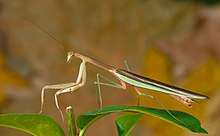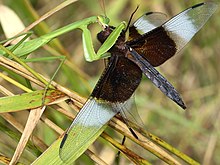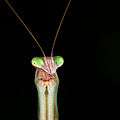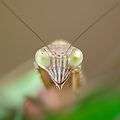Chinese mantis
The Chinese mantis (Tenodera sinensis) is a species of mantis native to Asia and the nearby islands. In 1896 this species was accidentally introduced by a nurseryperson at Mt. Airy near Philadelphia, United States.[2] Tenodera sinensis often is erroneously referred to as Tenodera aridifolia sinensis because it was at first described as a subspecies of Tenodera aridifolia, but Tenodera sinensis is now established as a full species.[3]
| Chinese mantis | |
|---|---|
 | |
| Adult male | |
| Scientific classification | |
| Kingdom: | Animalia |
| Phylum: | Arthropoda |
| Class: | Insecta |
| Order: | Mantodea |
| Family: | Mantidae |
| Subfamily: | Tenoderinae |
| Tribe: | Tenoderini |
| Genus: | Tenodera |
| Species: | T. sinensis |
| Binomial name | |
| Tenodera sinensis (Saussure, 1871) | |
| Synonyms | |
Tenodera sinensis feeds primarily on other insects, though adult females sometimes catch small vertebrates. For example, they have been documented as feeding on hornets, spiders, grasshoppers, katydids, small reptiles, amphibians, and even hummingbirds.[4] Like most mantids, they are known to be cannibalistic. One study found that cannibalism occurs in up to 50% of matings.[5] These mantids have been observed eating the larvae of monarch butterflies, while discarding the entrails.[6]

Description
The Chinese mantis is a long, slender, brown and green praying mantis. It is typically longer than other praying mantis species reaching just over 11 cm (4.3 in), and is the largest mantis species in North America (spread throughout the Northeast United States). Its color can vary from overall green to brown with a green lateral stripe on the borders of the front wings in the brown color form. In low light the eyes of the mantis appear black, but in daylight appear to be clear, matching the color of the head. Chinese mantids look similar to another mantis species that has been introduced to the United States, the narrow-winged mantid (Tenodera angustipennis). Tenodera sinensis and Tenodera angustipennis are similar in appearance, however you can tell them apart by locating a spot in between their front legs. If it is yellow then it is a Chinese mantis but if it is orange then it is a narrow-winged mantis. The female can produce several semi-spherical oothecae, roughly 2 cm (0.8 in) in diameter, containing up to 400 eggs. The oothecae are often affixed to vegetation such as bushes and small trees.
.jpg)
Native range
This mantis is native to China, Japan, the Korean Peninsula, Micronesia and Thailand.[1] Japanese 'Oo-kamakiri' ("large mantis") is known as Tenodera aridifolia, but this species can be considered T. sinensis.
Growth
First instar nymphs that eat less take a longer time to molt to the next instar and are smaller at the second instar than first instar nymphs that have been fed more.[7]
Captivity
Tenodera sinensis is a common pet for mantis enthusiasts, and oothecae can be purchased from plant nurseries across the US. They are notable for quickly adapting to the presence of humans. They can become tame enough to perch on one's hand and even be hand-fed.
Care
The Chinese mantis should be kept in a terrarium roughly three times its body size. The Chinese mantis is an aggressive carnivore that will tackle and eat large insects. In captivity the Chinese mantis' diet can consist primarily of cockroaches, moths, butterflies, grasshoppers, and crickets. As a first instar, Chinese mantids can be fed Drosophila melanogaster and other similarly sized insects in captivity. As they grow larger, mantids will accept house flies, blue bottle flies, moths, small roaches and crickets.
Water should be provided by gently misting the enclosure on a daily basis. The enclosure must have proper aeration to prevent the growth of mold. In the terrarium, mantids require sticks and other foliage for climbing and molting. Mantids will thrive in temperatures ranging from 20 to 38 °C.
Predators
The Chinese mantis is preyed on by other mantises, birds, and the Asian giant hornet in its native range.[8]
Culture
There are two martial arts styles created to mimic the movements of the Chinese mantis. Developed in the Shandong province of China in the mid-1600s, Praying Mantis kung-fu is based on the quick movements and techniques of the Chinese mantis. An unrelated style of kung fu that was developed by the Hakka people in Southern China is known as Southern Praying Mantis.
Master Mantis, one of the supporting characters in the 2008 Dreamworks Animation film franchise Kung Fu Panda is a Chinese Mantis and one of the members of the Furious Five.
Gallery
 Adult male
Adult male Adult female
Adult female Adult at rest
Adult at rest Adult female Tenodera sinensis eating a long-horned grasshopper
Adult female Tenodera sinensis eating a long-horned grasshopper- Sub-adult female in hand
See also
References
- "Archived copy". Archived from the original on 2014-10-13. Retrieved 2014-01-13.CS1 maint: archived copy as title (link) Texas A&M University
- Blatchley, Willis Stanley (1920). Orthoptera of northeastern America: with especial reference to the faunas of Indiana and Florida. The Nature Publishing Company. pp. 122–123.
- Ehrmann, R. 2002. Mantodea: Gottesanbeterinnen der Welt. Natur und Tier, Münster
- http://www.birdwatchersdigest.com/site/backyardbirds/hummingbirds/mantis-hummer.aspx?sc=birdwireJul2005
- https://royalsocietypublishing.org/doi/full/10.1098/rspb.2016.0656
- Duss, K.; Hurd, L E (1997). "Food limitation reduces body length in mantid nymphs, Tenodera sinensis Saussure (Mantodea: Mantidae): Implications for fitness". 99. Washington, etc. :Entomological Society of Washington. pp. 490–493. ISSN 0013-8797.
- https://www.youtube.com/watch?v=NUzqYtjBZ44
External links
| Wikimedia Commons has media related to Tenodera sinensis. |
Citizen science observations for Chinese mantis at iNaturalist